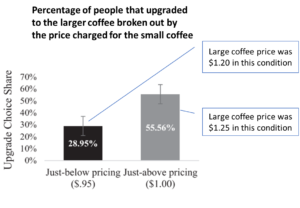Ask Amounts: $.99 and Upgrading
We wrote last week about the allure of $.99 pricing in the consumer world and argued for testing with $.99’s in the ask string.
The best test is appending education to your file (cheap, quick and easy) as proxy for numeracy, and having a split test since more numerate and less numerate people process prices differently.
To Recap:
- Higher numeracy (using higher formal education as proxy) people prefer to land on a “fluent neighbor” as they process prices/ask amounts and since they’ll mentally round up you choose $19.99 and $29.99 as an example.
- Less numerate folks focus on the the number to the left and you want that number to be fluent so $20.99 and $30.99 for them.
But what about upgrading these folks down the road? Do these “just-below” prices impact that likelihood?
If someone donated $19.99 what is the psychology of a $30 ask and how might it differ from that same person having given a penny more ($20) the first time?
People have lots of psychological thresholds that distort reality. For example, cities that are objectively closer to one’s home state but across state lines are considered further away that an objectively farther city in the same state. Temperature changes between two consecutive days seem larger when they fall in different months instead of the same month. We’re much more likely to prefer a software upgrade when it goes from version 2.9 to 3.0 vs. 2.8 to 2.9 and we think a person, place or thing ranked in 11th place is much worse than the person/place/thing in the 10th position but draw no distinction between 10th and 9th place.
In this experiment selling coffee there were two conditions:
- Just-below pricing: Small coffee costs $.95 and large costs $1.20
- Just-above pricing: Small coffee costs $1.00 and large coffee costs $1.25

Far more people upgraded to the large coffee when the small coffee was priced at $1.00 even though the price was objectively higher by $.05. Why? The $.95 pricing crossed a psychological threshold and felt like a much bigger price jump even though the increase was identical ($.25) and the absolute price was lower.
This experiment shows what we probably already intuitively knew, what folks will pay or donate is highly influenced by the relative nature of numbers. Each person will have some upper and lower boundaries tied to psychology and financial means but within those boundaries there is an enormous amount of influence we can have by thinking differently and more creatively about ask amounts. The days of ask strings built off the 1.25x increase over MRC or HPC should be long gone.
Kevin



While this is certainly fascinating, I’m hard-pressed to realistically envision how the small to medium-sized nonprofit (which 99% are) can put this into action. Suggestions? Do you know any nonprofits who’ve done the education appending as a proxy for numeracy? You say it’s inexpensive but, practically, how does one go about it? What about any nonprofits who’ve tested different subsequent ask strings for upgrading? How did it shake out? And is there a file size below which this type of test would be meaningless?
Plus, if you have to do the ask amounts/strings more-or-less the equivalent of manually (I’m old enough to remember doing this pre-computers), fuggeddaboutit. So… how many small NPOs have software that can do this? And, per your last article, if you have to avoid prime numbers — we’re getting pretty complicated. Or perhaps my brain is just enfeebled at this point!
This is certainly food for thought, and I can see how it works in for-profit sales, but… just not sure it’s realistic for the lion’s share of NPOs. Though I do like the idea in your previous article of trying a fluent base price with $.99 as a one-size fits all test. How much of a lift could one consider statistically meaningful? Thanks for always making me think!